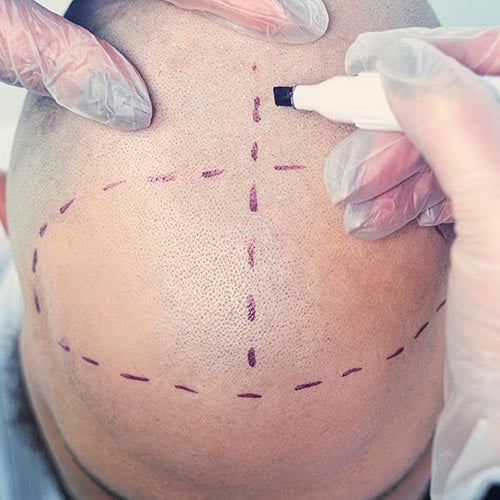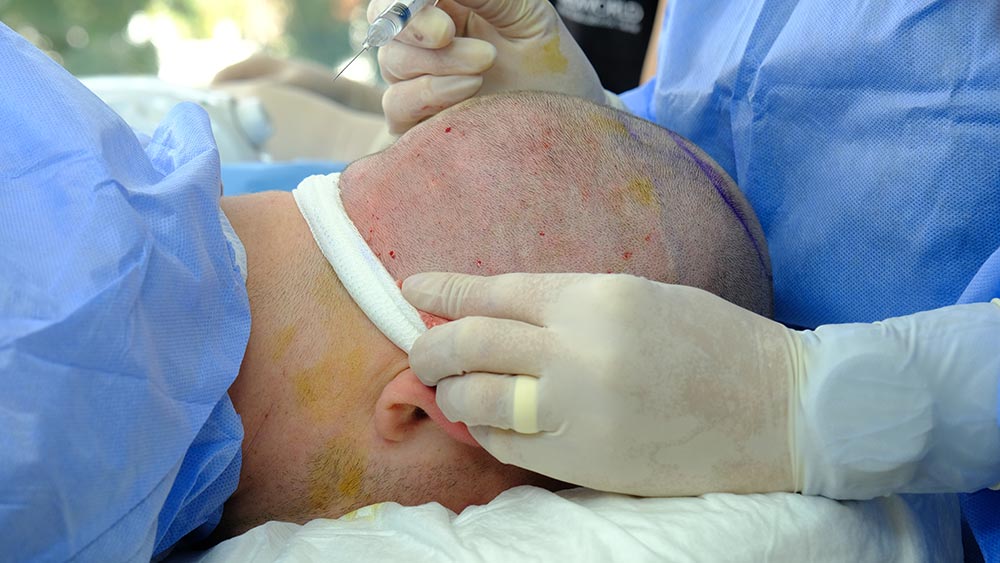What is Laser-Assisted Hair Transplant?
Laser-assisted hair transplant is a modern technique that uses laser technology to open the channels where hair follicles will be implanted, ensuring high precision during the process. This method allows for the follicles to be placed in alignment with the natural hair growth direction. The application of laser-assisted hair transplant shortens the procedure time and minimizes tissue damage. Laser technology also accelerates the recovery process, enhancing the success of aesthetic results. Providing both aesthetic and medical advantages, this method offers an innovative solution.


İÇİNDEKİLER
How is Laser-Assisted Hair Transplant Performed?
Laser-assisted hair transplant is a procedure where laser technology is used to create the channels for placing hair follicles with high precision. This method opens channels in the natural direction of hair growth, ensuring a natural appearance. The process is highly precise, placing hair follicles without damaging surrounding tissues. During the procedure, the laser’s effect on increasing blood circulation also contributes to the healing process.

Laser-Assisted Channel Creation Process
Laser technology creates channels for hair follicles with millimetric precision. This process minimizes damage to the scalp, leading to faster recovery. The laser-assisted hair transplant ensures that the channels are opened at the correct angle and density, guaranteeing a natural look.
Role of Laser in Placing Hair Follicles
Laser technology facilitates the accurate positioning of hair follicles. Placing the follicles in the natural direction of hair growth ensures aesthetically pleasing results after the procedure. The advantages of laser-assisted hair transplant lie in its precision and accuracy, distinguishing it from other methods.
Impact of Laser Technology on Procedure Time
Laser-assisted hair transplant reduces the duration of the procedure, offering a more comfortable process for both the patient and the doctor. The precision of the laser accelerates the placement of hair follicles. This advantage makes laser-assisted hair transplant a more efficient procedure compared to traditional methods.
What are the Advantages and Disadvantages of Laser-Assisted Hair Transplant?
Laser-assisted hair transplant is an innovative method that offers many advantages. While it provides benefits such as precise channel creation and rapid healing, the high cost of laser technology and its potential to cause skin sensitivity can be considered disadvantages. The main advantages of laser-assisted hair transplant are its ability to produce natural and permanent results.
Advantages of Laser in Providing Precision and Accuracy
Laser technology ensures high precision when placing hair follicles. This precision enhances the natural appearance of the hairline and positively affects the aesthetic results post-surgery. The advantages of laser-assisted hair transplant, such as this accuracy, contribute to higher satisfaction with the procedure.
Potential Side Effects of Laser on the Scalp
Although laser-assisted hair transplant is generally safe, it may cause temporary side effects such as skin sensitivity or redness. These reactions can vary depending on the skin type. Recovery after laser-assisted hair transplant tends to be smoother, as these side effects typically resolve quickly.
Long-Term Results of Laser-Assisted Hair Transplant
Laser-assisted hair transplant provides long-term and permanent results due to the accurate placement of hair follicles. The hairline and density are designed to blend naturally with existing hair. The main advantage of this method is its ability to deliver lasting aesthetic results.
How Does Laser Technology Contribute to the Hair Transplant Process?
Laser technology makes the hair transplant process more comfortable for both the patient and the doctor. This method causes minimal tissue damage, facilitating the precise placement of hair follicles. Additionally, the laser’s ability to enhance blood circulation supports the healthy attachment of hair follicles. The use of laser-assisted hair transplant makes the procedure more efficient and successful.
Consult Now!
Fill out the form to get detailed information about the hair
transplant process and personalized solutions tailored for you!
Role of Laser in Achieving a Natural Appearance
The laser ensures that hair follicles are placed in the natural direction of the hair. This allows for a more natural-looking hairline. Laser-assisted hair transplant is an ideal choice for patients with high aesthetic expectations due to this feature.
Laser’s Effect on Enhancing Blood Circulation
Laser technology improves blood circulation in the scalp, ensuring better nourishment for the hair follicles. This effect accelerates the recovery process after the transplant and increases the success rate of hair follicle retention. The recovery after laser-assisted hair transplant is faster and more comfortable due to this advantage.
Reducing Tissue Damage with Laser-Assisted Hair Transplant
Laser-assisted hair transplant places hair follicles without damaging surrounding tissues. This reduces the risk of infection and shortens the recovery time. The method ensures natural results while causing minimal tissue damage.
How Does the Recovery Process Work After Laser-Assisted Hair Transplant?
The recovery process after laser-assisted hair transplant is faster and more comfortable compared to other techniques. The minimal tissue damage caused by the laser allows for better attachment of the hair follicles. The first week is critical for the placement of hair follicles and the initiation of the healing process. Following proper care and expert recommendations ensures a successful recovery. The benefits of laser technology speed up the recovery process, allowing for faster results.
Laser's Role in Accelerating the Healing Process
Laser technology enhances blood circulation in the scalp, speeding up the healing process. Increased circulation improves the nourishment and retention of hair follicles. Additionally, minimal tissue damage reduces the risk of infection. Thanks to these technological advantages, recovery after laser-assisted hair transplant is faster and more comfortable.
What to Keep in Mind During the First Week After Laser-Assisted Surgery
The first week after laser-assisted hair transplant is one of the most critical periods. It is important to protect the scalp from impacts and direct sunlight. Keeping the area clean and using the recommended care products consistently are essential. When managed with care, the recovery process after laser-assisted hair transplant is more successful.
Laser Technology’s Impact on the Crusting Process
In laser-assisted hair transplant, the minimal tissue damage results in a quicker and more comfortable crusting process. The laser’s precision in creating channels helps control the formation of crusts, accelerating the natural healing process. This feature of laser-assisted hair transplant increases the comfort of patients during recovery.
Who Is Suitable for Laser-Assisted Hair Transplant?
Laser-assisted hair transplant is an ideal option for individuals with suitable hair loss types and general health conditions. This method provides effective results for individuals experiencing genetic hair loss. However, a thorough evaluation is conducted beforehand to determine a person’s suitability for the procedure. The advantages of laser-assisted hair transplant become more pronounced in suitable candidates.
Effectiveness of the Laser Method Based on Hair Loss Type
Laser-assisted hair transplant is particularly effective for genetic hair loss types, such as androgenetic alopecia. The precise placement of hair follicles in the correct positions increases the method’s success rate. Laser-assisted hair transplant is tailored based on the hair loss type for optimal results.
Health Conditions for Laser-Assisted Hair Transplant
Individuals seeking laser-assisted hair transplant should have good general health. Those with chronic conditions like diabetes or hypertension need a thorough evaluation before undergoing the procedure. The benefits of laser-assisted hair transplant are more pronounced in healthy individuals, leading to more effective results.
Effectiveness of the Laser Method Across Age Groups
Laser-assisted hair transplant offers effective results across various age groups. In younger individuals, the strength of the hair follicles speeds up the healing process, while in older patients, permanent results can be achieved with proper planning. Laser-assisted hair transplant can be customized based on the age group for optimal outcomes.
Comparison of Laser-Assisted Hair Transplant and Traditional Techniques
Laser-assisted hair transplant offers a more precise and faster process compared to traditional methods. The precision provided by laser technology creates a noticeable difference during the procedure and in the final results. The advantages of laser-assisted hair transplant stand out in terms of a natural appearance and minimal tissue damage.
Success Rates of Laser and Manual Techniques
Laser-assisted hair transplant has a higher success rate compared to manual techniques. The ability of the laser to create precise channels and place hair follicles in the correct directions enhances the quality of the aesthetic results. Recovery after laser-assisted hair transplant is supported by this higher success rate.
Impact of Laser-Assisted Methods on Natural Hairline
Laser technology plays a significant role in creating a natural hairline. Hair follicles are placed according to their natural growth direction with laser-assisted methods. The application of laser-assisted hair transplant ensures satisfying aesthetic outcomes.
Consult Now!
Fill out the form to get detailed information about the hair
transplant process and personalized solutions tailored for you!
Cost and Time Advantages of Laser-Assisted Hair Transplant
Laser-assisted hair transplant shortens the procedure time, offering a more comfortable process for both the patient and the doctor. However, the cost of the technology may be higher compared to traditional methods. The advantages of laser-assisted hair transplant, combined with cost and time benefits, make it a more attractive option.

